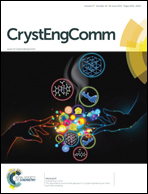Structural diversity of coordination polymers controlled by the metal ion as the sole reaction variable†
Abstract
Three new coordination polymers based on 4,4′-(ethyne-1,2-diyl)dibenzoic acid (H2edba) and 2,2′-bipyridine (bpy) ligands, namely, [Zn(edba)(bpy)]·xGuest (1), [Cu(edba)(bpy)]·xGuest (2), and [Co3(edba)3(bpy)2]·3DMF·H2O (3) (DMF = N,N-dimethylformamide), were synthesized under the same solvothermal conditions except for the use of different metal ions. Single-crystal X-ray analysis indicates that with the different coordination habits of Zn2+, Cu2+, and Co2+ ions, the resulting compounds feature coordination structures with different dimensionalities, namely, a 1D zigzag chain based on single-ion nodes in 1, a 2D sql layer based on dinuclear 4-connected nodes in 2, and a 3D sxb framework based on trinuclear 6-connected nodes in 3. In addition, after the removal of guest molecules, the 2D framework of 2 and the 3D framework of 3 are stable enough for CO2 sorption with Langmuir surface areas of 440 cm2 g−1 and 542 cm3 g−1, respectively. The present study serves as an example, in which the metal ion acts as the sole reaction variable, demonstrating the significance of the metal ion in the structural diversity of coordination polymers.


 Please wait while we load your content...
Please wait while we load your content...